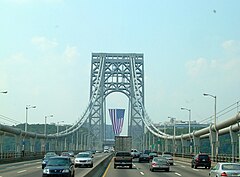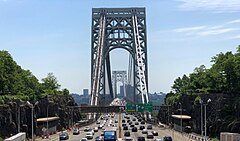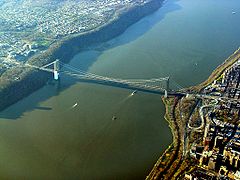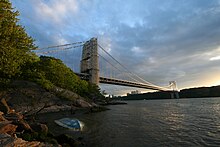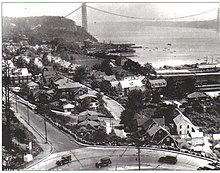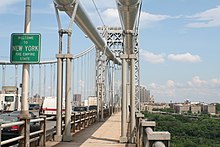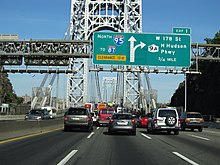George Washington Bridge
[39] Stiffening trusses were ultimately excluded from the George Washington Bridge's design to save money; instead, a system of plate girders was installed under the upper deck.
[46][47] Originally, the end of each cable was supposed to receive one of several ornamental designs, such as a wing, fin, tire, or statue; cost-savings after the start of the Great Depression in 1929 preempted the flourishes.
[49][15][51] Additional scrutiny of the proposed bridge's engineering found that the steel alone could support the towers,[52] with only a decorative stone facade being retained in the plan.
[59] While the exposed steel towers' design was negatively received by a few critics such as Raymond Hood and William A. Boring, the public reception at the bridge's opening was generally positive.
[18] The Swiss-French architect Le Corbusier wrote of the towers: "The structure is so pure, so resolute, so regular that here, finally, steel architecture seems to laugh.
[65] On events where the flag is flown, the tower lights are lit from dusk until 11:59 p.m.[1] The bridge sits near the sites of Fort Washington (in New York) and Fort Lee (in New Jersey), which were fortified positions used by General George Washington and his American forces as they attempted to deter the occupation of New York City in 1776 during the American Revolutionary War.
[66][b] By the end of the 19th century there were more than 200 separate municipalities along the lower Hudson River and the New York Bay, with no unified agency to control commerce or transport in the area[68] and no fixed crossing.
[73][75] In 1920, English architect Alfred C. Bossom proposed a double-decker bridge with room for vehicular and railroad traffic near 57th Street in Midtown Manhattan.
[85][86] In late March 1925, the chairman of the Parks Conservation Association noted that the proposed New York state legislation would provide for the actual construction of the bridge, rather than just the planning.
[9] Cass Gilbert was hired in January 1926 to design architectural elements for the Hudson River bridge, including the suspension towers.
[40][117] Ultimately, the Port Authority chose the wire-cable design because of costs, and it awarded the contract for constructing the deck to John A. Roebling Sons' Company.
The first strand of the first main cable was hoisted between both towers in July 1929, in a ceremony attended by the governors of both states and the mayors of New York City and Fort Lee.
[141] That month, the Port Authority opened the bidding process for contracts to build the Hudson River bridge's approaches on the New York side.
[15][147] However, the Port Authority formally adopted the "George Washington" name on January 13, 1931, honoring the general and future president's evacuation of Manhattan at the bridge's location during the Revolutionary War.
[77][149] Shortly afterward, the Port Authority Board of Commissioners voted to reconsider the renaming of the Hudson River Bridge, stating that it was open to alternate names.
[153][154] This decision was applauded by then-congressman Fiorello La Guardia, who felt that other options "insulted the memory of our first President and encouraged the Reds".
[156] Later that month, the agency published a report, which stated that the bridge's early opening date was attributable to how quickly and efficiently the various materials had been transported.
[169] The bridge was later credited with helping raise land prices and encouraging residential development in formerly agricultural parts of Bergen County.
[230] Starting on July 4, 2000, and for subsequent special occasions, each of the George Washington Bridge's suspension towers has been illuminated by 380 light fixtures that highlight the exposed steel structure.
[21][244] The staircases leading to the sidewalks on both the northern and southern sides of the upper deck were also being replaced with ramps that were compliant with the Americans with Disabilities Act of 1990.
[244] On the New Jersey side, the Palisades Interstate Parkway "Helix" ramp onto the bridge would be replaced at a cost of $112.6 million; this was completed in March 2019.
[253] Originally, the approach to the George Washington Bridge from the New York side consisted of a roundabout encircling a fountain, which was designed by Cass Gilbert.
[268] In March 2020, due to the COVID-19 pandemic, all-electronic tolling was temporarily placed in effect for all Port Authority crossings, including the George Washington Bridge.
[289] Though it offers direct access into Palisades Interstate Park, the northern sidewalk requires stairway climbs and descents on both sides, which was inaccessible for people with physical disabilities and posed a risk in poor weather conditions.
[293] As part of the project to replace the bridge's vertical support cables, the connections to both sidewalks will be enhanced or rebuilt and made ADA-compliant.
On September 21, 1930, a stunt jumper named Norman J. Terry jumped off the bridge's deck in front of a crowd of thousands, and because his body was facing the wrong way, he broke his neck upon hitting the water.
The local toll lane reductions caused massive traffic congestion, with major delays for school transportation and police and emergency service responses within Fort Lee.
[308] After a four-month investigation, it was revealed that the lane closures were made by the aides and appointees of New Jersey Governor Chris Christie, causing a political scandal.
[34] During the terrorist attacks on September 11, 2001, several news organizations, including CNN, reported that a vehicle filled with explosives had been found on the lower level of the bridge.
In the opening singalong for Sesame Street, Ernie sang the words "George Washington Bridge" to the tune of Sobre las Olas ("The Loveliest Night of the Year").


